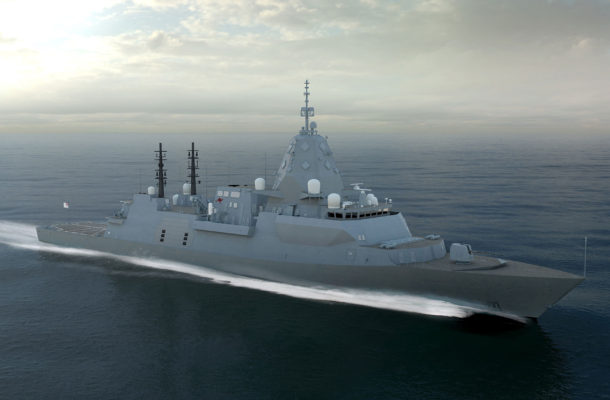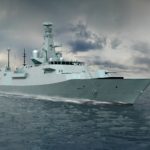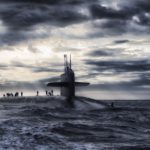Defence contracts open opportunities for SMEs and skilled workers

British defence giant BAE Systems is stepping up its campaign to win Australia’s lucrative Future Frigate contract by promising greater opportunities to Australia’s small to medium sized enterprises across a global shipbuilding programme.
BAE Systems is offering the Global Combat Ship-Australia for the SEA 5000 project, a variant of the new Type 26 frigates being built for the Royal Navy. If its Australian bid is successful, Australian SMEs will have the chance to supply not only Australia’s 9 ship program but the 8 vessels earmarked for the UK.
Tasmania’s Liferaft Systems Australia and Victoria’s Mackay Consolidated Industries have already won contracts on the UK Type 26 Global Combat Ship program for the Royal Navy and BAE Systems Australia chief executive Glynn Phillips said the company is looking to increase the number of Australian businesses contributing to the project.
“Australian businesses have proved they are internationally competitive and can win work in global markets, creating important export sales,” Phillips said. “As a leading global exporter of defence equipment, our long-term ambition is to build upon this and create a global shipbuilding export hub in Australia.
“Seventeen ships provides Australian industry with a better chance to increase the skills and capabilities of local suppliers and ultimately deliver a more sustainable local shipbuilding industry.”
Australian businesses could secure more opportunities across the global shipbuilding program if BAE Systems’ joint proposal with Lockheed Martin Canada is chosen to deliver up 15 ships for the Canadian Surface Combatant (CSC) project, a project worth up to CAD$60 billion.
BAE and the UK government have committed to the transfer of more than $1.5 billion of technical design and intellectual property to Australia if BAE Systems secures the SEA 5000 project.
BAE Systems has also said it will establish a digital shipyard that will transform Australia’s shipbuilding industry and facilitate a transfer of intellectual property and technical data, including the digital ship design optimised for the production of the Global Combat Ship.
The innovative digital shipyard will bring the “ship to life” during its service, with intelligent systems on board and linked to those ashore monitoring the performance of the ship and its systems. The digital shipyard will also include an inventory of parts, including details of their cost, acoustic signature and suppliers.
BAE Systems also recently unveiled its workforce mobilisation strategy for the SEA 5000 project. Its recruitment strategy would include an Early Careers Program to create a pipeline of apprentices and graduates throughout the build phase of the $35 billion project.
The UK contender would train 150 apprentices in steelwork, mechanical, electrical and technical trades, creating a core workforce to underpin the company’s strategy to ensure the necessary breadth and depth of skilled workers are available to service the 35 year programme.
A graduate program for business and engineering students would also offer opportunities for international placements across the company’s global business interests. BAE Systems offers a wide range of defence platforms, electronic systems and services, ranging from the Royal Navy’s new aircraft carriers to the Typhoon fighter jet, unmanned drones and tanks and armoured fighting vehicles.
Italian based multi-national Fincantieri and Spanish state owned Navantia are also tendering for the chance to replace Australia’s 8 Anzac frigates from the mid 2020s. Both firms also emphasise their commitment to expanding and training their local workforce and developing links to the Australian supply chain.
The winner of the Future Frigate tender will be announced by the Federal government in 2018.
Developing STEM skills for the Defence industry
The need to develop science, technology, engineering and maths skills to meet the growing needs of the Defence industry was stressed by Defence minister Marise Payne at the inaugural STEM in Defence conference in Canberra.
“It’s not possible to overstate the level challenge we are faced with,” the Senator told representatives from the Department of Defence, the Defence Science Technology group and major industry partners including Boeing, BAE Systems and Navantia Australia.
“We are changing the shape of our workforce and our recruitment messages needs to reflect that,” she said, urging a broad, cross-agency approach to avoid inter-departmental ‘cannibalization’ of talent.
Matt Ramage, the Assistant Secretary of Defence Industry, also accepted that a Defence STEM strategy is a national priority rather than purely a defence sector endeavour. Although the Department of Defence has a crucial role to play, it will need to work with other stakeholders in industry and education to raise the broader level of STEM skills at school, university and the existing workforce.
“With the continuous shipbuilding program in South Australia, specific skills will be required,” Mr Ramage said. “And more advertising and promoting of the Defence Industry as a career path for young Australians is needed.”
A career in Defence now expands far beyond actual front-line combat duty. The DST has already allocated $1.6 billion innovation initiatives over the decade, including $730 million for the Next Generation Technology Fund, opening a wide range of technical and innovation opportunities for Australian firms and skilled workers.
The Federal government’s Defence STEM strategy embraces five domains, with cyber and space joining the traditional triumvirate of land, sea and air.
“Scientists will be just as important as our front line soldiers and their ability to cut code quickly will be critical,” noted Army Drones Programs Brigadier, Chris Mills, Director General Modernisation – Army. Unmanned aerial systems are becoming an increasingly important part of airborne recon and attack missions and he argued that service personnel in all branches of the military will need to understand and engage comfortably with these technologies.
The future Defence workforce will include thousands of businesses and workers across Australia, and more skilled young workers will be required to fill trade and scientific roles. Shelley Willsmore from BAE Systems explained that 60% of their workforce has STEM skills but 35% are already over 50 years old.
“Looking at the growth that’s about to hit us, we see the challenges” she said. The increase in naval shipbuilding spurred by the growing threat posed by a resurgent Russia and increasingly belligerent China means that BAE Systems plans to recruit 2000 STEM graduates by 2018 and the company will need to look at new avenues to attract people at all levels of their careers.
The need to publicise the full breadth of high tech jobs in the Defence force was also stressed by Pauline Richards, the Director of Human Resources at Navantia Australia. “Australia will be at the forefront of the shipbuilding industry. We need to sell our industry as an industry where you can gain more than you ever thought possible.”
Offshore Patrol programme already underway
In November the Turnbull Government announced that Australia’s 12 Offshore Patrol Vessels will be designed and built under prime contractor Lürssen. The new class of ships are designed to protect Australia’s borders and offer greater range and endurance than the existing Armidale fleet with the ability to operate in more complex maritime environments.
The announcement was the latest stage in Australia’s National Shipbuilding Plan and will directly employ up to 1000 Australian workers – 400 direct and a further 600 in the supply chain. The Offshore Patrol Vessel project, worth up to $4 billion, will be delivered by Australian workers, in Australian shipyards as part of the largest regeneration of naval capability since the Second World War.
The first two OPVs will be built at ASC Shipbuilding in Adelaide with the project then transfering to the Henderson Maritime Precinct in WA where Lürssen will use the capabilities of Austal and Civmec to build ten OPVs, subject to the conclusion of commercial negotiations.
The first of the 12 OPVs will commence production in the fourth quarter of 2018.








